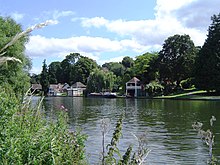| Revision as of 03:25, 21 December 2011 editCydebot (talk | contribs)6,812,251 editsm Robot - Removing category Thames Path per CFD at Misplaced Pages:Categories for discussion/Log/2011 December 8.← Previous edit | Revision as of 22:10, 14 January 2012 edit undoMotmit (talk | contribs)Autopatrolled, Extended confirmed users, Pending changes reviewers26,275 edits Update refNext edit → | ||
| Line 1: | Line 1: | ||
| {{stack begin}} | {{stack begin}} | ||
| {{Infobox Waterlock | {{Infobox Waterlock | ||
| |lock_name = Goring Lock<ref></ref> | |lock_name = Goring Lock<ref> Part 2 p17</ref> | ||
| |image= GoringLock03.JPG | |image= GoringLock03.JPG | ||
| |caption= The view of Goring Lock from Goring and Streatley Bridge | |caption= The view of Goring Lock from Goring and Streatley Bridge | ||
Revision as of 22:10, 14 January 2012
| Goring Lock | |
|---|---|
 The view of Goring Lock from Goring and Streatley Bridge The view of Goring Lock from Goring and Streatley Bridge | |
| Waterway | River Thames |
| County | Oxfordshire |
| Maintained by | Environment Agency |
| Operation | Hydraulic |
| First built | 1787 |
| Latest built | 1921 |
| Length | 179’ 5” (54.68m) |
| Width | 21’ 0” (6.40m) |
| Fall | 5’ 10” (1.77m) |
| Above sea level | 136' |
| Distance to Teddington Lock | 65 miles |
| Power is available out of hours | |
| Goring Lock | |||||||||||||||||||||||||||||||||||||||||||||||||||||||||||||||||||||||||||||||||||||||||||||||||||||||||||||||||||||||
|---|---|---|---|---|---|---|---|---|---|---|---|---|---|---|---|---|---|---|---|---|---|---|---|---|---|---|---|---|---|---|---|---|---|---|---|---|---|---|---|---|---|---|---|---|---|---|---|---|---|---|---|---|---|---|---|---|---|---|---|---|---|---|---|---|---|---|---|---|---|---|---|---|---|---|---|---|---|---|---|---|---|---|---|---|---|---|---|---|---|---|---|---|---|---|---|---|---|---|---|---|---|---|---|---|---|---|---|---|---|---|---|---|---|---|---|---|---|---|---|
| Legend | |||||||||||||||||||||||||||||||||||||||||||||||||||||||||||||||||||||||||||||||||||||||||||||||||||||||||||||||||||||||
| |||||||||||||||||||||||||||||||||||||||||||||||||||||||||||||||||||||||||||||||||||||||||||||||||||||||||||||||||||||||
Goring Lock is a lock and weir situated on the River Thames in England at the Goring Gap in the Chiltern Hills. The lock is located on the Oxfordshire bank at Goring-On-Thames, with Streatley, Berkshire on the opposite side of the river. It is just upstream of Goring and Streatley Bridge. The lock was first built in 1787 by the Thames Navigation Commissioners
The weir runs back to an island under the bridge and then another weir goes from there to the Streatley bank.
History
There was originally a weir and ferry here belonging to Goring Priory, which became the property of millers who kept a flash lock. A report in a newspaper of 1674 tells how 60 people drowned in the lock when the ferryman rowed too close to it. The pound lock was built in August 1787 from oak. Over several decades operation of the lock appears to have been shared with that of Cleeve Lock until 1869. Following this there were plans to build a lock-house, but this was not started until 1879. The lock itself was replaced in 1886. In the last rebuild in 1921 the lock had intermediate gates installed, making two pounds, but these were removed in the refit in 2003.
Access to the lock
The lock is situated almost under the bridge and is easily accessible from both Goring and Streatley
Reach above the lock
The reach is only just over half a mile long. The Cleeve side of the river is occupied by large gardens stretching down the hillside with several boat-houses on the river. There are islands below Cleeve lock, with weirs between them, and these extend for some distance. On the Streatley side are meadows and woods.
The Thames Path, having crossed Goring Bridge to Streatley, continues through on the western bank to Cleeve Lock.
 |
 |
See also
References
- A User's Guide to the River Thames Part 2 p17
- Fred. S. Thacker The Thames Highway: Volume II Locks and Weirs 1920 - republished 1968 David and Charles
| Next lock upstream | River Thames | Next lock downstream |
| Cleeve Lock 0.62 miles |
Goring Lock Grid reference: SU596808 |
Whitchurch Lock 4.07 miles |
51°31′23″N 1°08′32″W / 51.52298°N 1.14235°W / 51.52298; -1.14235
This article about a Berkshire building or structure is a stub. You can help Misplaced Pages by expanding it. |